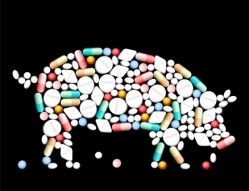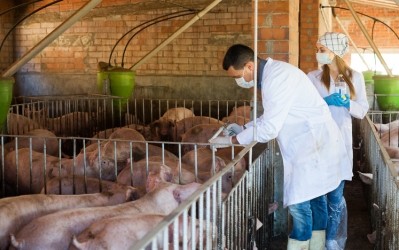Gaps remain in US oversight of antibiotic use in production animals

The GAO released a report highlighting the areas where it found more work was needed by the FDA and USDA.
John Neumann, director in GAO’s natural resources and environment team and co-author, said the publication also proposes ways the agencies could move forward.
The GAO had been following progress made by the Department of Health and Human Services through its Food and Drug Administration (FDA) and US Department of Agriculture (USDA) in tracking or documenting the use of medically important antibiotics since an initial report in 2011.
“We knew they were making some progress and there [had been] some positive steps [taken] to gather information,” he told FeedNavigator. “We were hoping that there had been more progress, and that’s why we made some additional recommendations.”
This report also draws comparisons with similar efforts undertaken internationally, he said. “We looked at other countries and what they were doing to gather data and discussed those with agency officials,” he added.
Future recommendations
One recommendation for the FDA, was that it establish specific timelines regarding its setting of use duration on labels, said Neumann.
“Part of getting things done is to have timeframes to establish appropriate use,” he said. “That was something that we know FDA has been thinking about, but they don’t have anything in place that says, ‘Here’s what we’re going to do and when.’”
The agency also could improve oversight of antibiotics that are not administered in feed, he said. The FDA has made improvements in how it documents the use of antibiotic products in feed and water, but not with other delivery methods.
“Part of the challenge here is that this has been going on for a number of years so though there would be help in determining timeframes to take those steps – we don’t know if there will be changes with the new administration,” said Neumann. “But we’ll follow up with the agency later this year to see what progress [has been made].”
And the FDA could set performance measures to manage use of antibiotics and offering guidance documents on judicious use, said the report authors.
For APHIS, one of the recommendations was to clarify the memorandums of understanding that had been established regarding cooperation in case of a foodborne illness outbreak to allow for on-farm investigation and when it is a reasonable practice, said Neumann.
“We looked at the recent [salmonella] outbreak, and they didn’t really know when would be appropriate to go on farm and collect data,” he said. “There is sensitivity about going on-farm.”
More discussions involving all stakeholders are needed to better establish that procedure, he said. When there is an outbreak of a foodborne illness, it is important to locate and visit the source.
Additionally, APHIS needs to set performance measures and goals for gather farm-specific data on both antibiotic use in food animals and antibiotic resistant bacteria found, said the authors.
Antibiotic use in livestock
The rise of infection-causing bacteria that are resistant to antibiotics is considered to be a threat to global health, says the World Health Organization (WHO). The Centers for Disease Control and Prevention (CDC) estimate that antibiotic-resistant bacteria account for about 2m illness and 23,000 deaths a year in the US.
The WHO has said that the overuse and misuse of antibiotics in veterinary and human medicine is linked to the emergency and growth of antibiotic resistant bacteria. There also is evidence, according to the CDC, that some antibiotic resistant bacteria stem from the use of antibiotics in livestock.
In the US, the FDA approves the sales, checks the manufacturing and sale of antibiotics used in certain animal species. And agencies within the USDA, including the Food Safety and Inspection Service (FSIS) and the Animal and Plant Health Inspection Service (APHIS), gather data about antibiotic use and resistance in production animals and offer education about correct antibiotic use.
GAO report overview: gaps in US oversight
The USDA has improved its data collection activities on the use of antibiotics in livestock and, through improvements to the National Antimicrobial Resistance Monitoring System, to tracking bacterial resistance, found the GAO report.
The FDA has also changed regulation and guidance for industry regarding drug labels for medically important products used in animal feed or water, said the authors. And the Center for Disease Control and Prevention, the FDA and the USDA released a report on the genetic sequences of bacteria to aid surveillance and information gathering, noted the authors.
Although changes have been made to drug labels, they do not completely address long-term and open-ended feeding or use of antibiotics, concluded the report.
Some antibiotic products do not include a time duration for use on their label, said the authors. The FDA has been collecting comments aimed at setting use durations on labels, but there is no set timeline for doing so, noted the GAO report.
Revisions made to the use of medically important antibiotics requiring veterinary oversight only applied to the use of drugs in animal feed or water, but not through injections or other routes, they said. The FDA said that a plan is in progress to expand antibiotic stewardship to include alternative delivery methods, but the plan is still being developed.
“Without a published plan documenting the steps to increase veterinary oversight of medically important antibiotics administered through routes other than feed and water, such as injections and tablets, FDA will not know whether it is making progress in achieving its objective of ensuring judicious use of medically important antibiotics in food animals,” noted the GAO publication.
Additionally, previously identified holes in farm-specific data recording regarding both antibiotic use and resistant bacteria have not been addressed, said the authors. Some progress has been made, but no joint plan to maximize financial resources for the effort has been established.
“There are still critical gaps in antibiotic use data, including the amount and specific types of antibiotics used across the various food animals and the indications for their use; these data are needed to further assess the relationship between antibiotic use and resistance in bacteria,” they said. “Moreover, these data are important for assessing the impact of actions being implemented by FDA to foster the judicious use of medically important antimicrobial drugs, including the use of antibiotics in food animals, according to FDA officials.”
The Food Safety and Inspection Service (FSIS) has established a performance metric to assess its actions regarding the management of antibiotic use with food producing animals, said the authors. However, FDA and USDA’s Animal and Plant Health Inspection Service (APHIS) have not.
There also is a lack of understanding on how to decide when to conduct on-farm investigations if there is an outbreak of foodborne illness, including when they stem from antibiotic-resistant pathogens in animal products, they added. And no on-farm investigations during an outbreak have been done.
When such an outbreak happened, there was no agreement on whether on-farm investigations were needed, they said.







